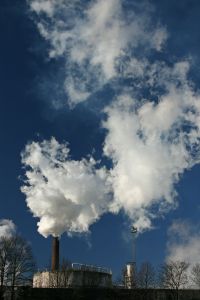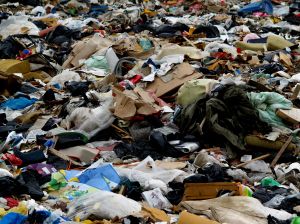
![]()
index.html>Incineration and Acidity after NaoH Scrubbers Incineration and Acidity after NaoH Scrubbers
Flue gases are frequently scrubbed with alkali (NaOH) to trap acidic combustion products and then passed through an electrostatic precipitator to remove particulates, such as rust. Problems were encountered at two sites, leading the operator to decide against neutralization as a major chemical demilitarization process: ''the rationale for abandoning neutralization was reportedly based on a number of factors: (1) the sheer complexity of the process (as compared to incineration ), (2) the quantity and nature of the waste that was produced, and (3) the high capital .and operating costs'' (Flamm et al., 1987). As the exhaust gases cool new, unknown compounds form, some of which are very toxic and are released into the air or retained in the ash.
There is no way to adequately monitor what goes into the incinerator. The hot exhaust gases are first cooled by supplying the latent heat of
evaporation to the liquid scrubber solution. The contaminants of the exhaust gas are neutralized by a suitable reagent such as sodium hydroxide
in the case of acidic contaminants and the product is collected in the scrubbing solution. Dissolve or mix material with a combustible solvent and burn in a chemical incinerator equipped with an afterburner and scrubber. Wear self-contained breathing apparatus, rubber boots and heavy rubber gloves. In recent years, contamination of toxic organic compounds such as polychlorinated dibenzo- p -dioxins and dibenzofurans (PCDD/Fs), and polychlorinated biphenyls (PCBs) into combustion/incineration ash and soil has become a serious environmental problem. Many efforts have been made to develop efficient remediation technologies which remove, neutralize and/or decompose such compounds in solid materials. The emissions to the atmosphere are discussed in detail in terms of odour, dust and litter, particulate metals and salts, and chlorine, fluorine, sulphur and nitrogen compounds. The products of incomplete combustion of waste are reviewed with particular emphasis on polycyclic aromatic compounds, dioxins and furans. Liquid or solid - cover with a reducer (sodium thiosulphate, a bisulphite or a ferrous salt not carbon, sulphur or strong reducing agent). Mix well and spray with water. High efficiency removal of the finer particles is critical to meet emission limits for the volatile metals. An ionizing wet scrubber (IWS) is the most effective device to insure the highest efficiency removal at the lowest possible energy usage. This system was attached to the vent of the existing chilled toluene recovery system. The new refrigerated condenser was then connected to an existing on-site vent gas incinerator because one of the reaction byproducts, ethylene, cannot be condensed without expending a large amount of energy. To meet codes on heavy metal particulate emissions, wet scrubbing systems produce a large pressure drop in the flue gas stream. Even their wet scrubbers cannot meet the codes. Cleanup involved thorough cleaning out of all wastewater pretreatment system sumps and trenches, repiping of all pretreatment system sources, treatment and cleaning of grossly contaminated surfaces and equipment, and a final steam cleaning. The system was heated and insulated to avoid heat loss. The dilute caustic recirculation loop was fitted with connections for caustic purge and makeup. The fuel systems in liquid fueled air-breathing missiles utilize bladders which must be pressurized to expel the fuel. Gas generators used to pressurize these bladders must meet certain specifications not normally required of gas generators. The first indication of a leak in the system is usually the presence of the distinctive amine odor. The source of the odor can be readily pinpointed by using a sulfur dioxide (SO2) lecture bottle fitted with a high pressure (2,000 psig) needle valve, pressure gauge, and a 3-ft length of stainless steel tubing. The evolved reaction gases should be routed through a decontaminate filled scrubber before release through filtration systems. After completion of the one hour minimum agitation, 10% sodium hydroxide is added in a quantity equal to that necessary to assure that a pH of 12.5 is maintained for a period not less than 24 hours. The input mix material for this system must have at least 70% of organic matter content to operate successfully. An industrial scale plant is
in operation in India. Volume 2, Chapter 3 of this assessment gives an overview of dioxin emissions from incineration technologies equipped with
a variety of pollution control systems. The evolved reaction gases should be routed through a decontaminate filled scrubber before release through filtration systems. After completion of the one hour minimum agitation, 10% sodium hydroxide is added in a quantity equal to that necessary to assure that a pH of 12.5 is maintained for a period not less than 24 hours. The input mix material for this system must have at least 70% of organic matter content to operate successfully. An industrial scale plant is in operation in India. Volume 2, Chapter 3 of this assessment gives an overview of dioxin emissions from incineration technologies equipped with a variety of pollution control systems. Customer information, profiles and shipping documents are entered into the computer system to generate Pollution Control Industries operating records. PCI will continue with its efforts and research into future developments of computer based technology. About 18% (or 25 gigawatts) utilized spray-dry scrubbers or sorbent injection systems. As optional, we can offer electrical control panel with this system with automation as far desired. This will include incoming curcuit breaker, instruments , outgoing circuit breaker for each equipment to be used, bus bar etc and whatever is needed. Visit the Waste Treatment Technologies web site. for more information. |
Biomedical Waste Incineration Waste Incineration Plants Revealed Sewage Sludge Incineration Mechanical Biological Treatment Incineration and Acidity after NaoH Scrubbers Waste Water Treatment Technology for Organic Waste Disclaimer Privacy Statement |
(c) 2008 Waste Technologies Multi-Site

